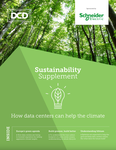Digitalization has become an imperative for every industry, especially in the wake of Covid. Every industry is also experiencing a climate change wake-up call, so to speak, with pressure put on increasing sustainable operations and decreasing emissions. For the data center industry, power has always been mission critical. But with the push to boost decarbonization efforts, adoption of Electricity and Hydrogen driven systems is a key focus. And this means data center operators are looking at digitalized grid edge solutions as essential for sustainability and modernization success.
Battery energy storage systems are a critical part of bringing this modern – and sustainable – data center to the grid. We’ve seen Big Tech already invest in battery storage with Google unveiling plans in late 2020 to replace a diesel with a backup battery for the first time, at a Belgium data center. Google’s ultimate ambition is to use the project as a test case for grid service applications. Investing in battery storage as a backup method is an attractive bet for IT leaders replacing traditional diesel generators. Yet this can be costly and ineffective for hyper-scale centers that are larger and may not be able to operate on batteries alone. A layered approach, including additional solutions and methodologies, is necessary.
The hydrogen revolution on the horizon
Leveraging hydrogen and solar for data center backup generation can have a significant impact on the life of a data center and its sustainability. More specifically, hydrogen’s versatility and efficiency may prove to be a valuable asset for data centers as they boost decarbonization in the coming years. With the hydrogen generation market expected to grow from $130 billion in 2020 to $201 billion by 2025, it’s critical for data center operators to integrate plans to invest and implement these solutions now.
Hydrogen is an attractive investment amongst IT decision-makers today because it has the potential to create a full network of operations for data centers beyond just backup generation. It can also be used for storage efforts and provide load balancing services to the grid. In addition, storing green hydrogen that is developed onsite by renewable electricity can be used to power fuel-cell vehicles, offering emissions-free transportation for onsite operations. Layering solar and hydrogen can generate fuel. Water can be used as fuel through hydrogen power cells to power data centers. In between the use of solar and hydrogen is where battery energy storage systems come into play, blending all three methods to provide a number of backups to optimize data center use without wasting energy.
Alongside Google, Microsoft is another example of a company layering data centers with multiple emerging technologies for backup generation. The company is experimenting with testing hydrogen fuel cells for data center backup generation in order to meet its commitment to be carbon negative by 2030.
Layering your data center with grid edge solutions
Solar power is another viable option to improve data center resiliency as a renewable source of backup power. In fact, data center housing is often constructed to withstand above-average environmental conditions, sporting flat roofs for solar panels. Research from U.S. National Renewable Energy Labs (NREL) has found that tying the solar production to systems within data center buildings can help extend generator runtimes, maintain uptime with battery and solar in the event fuel was exhausted, provide operational savings, and improve reliability.
While solar is an effective backup method, it should be considered a complement to hydrogen. It’s critical to understand that when deciding which solutions to invest in – whether it be battery energy storage solutions, hydrogen or solar – one option should not be prioritized over the other. Instead, these solutions need to be layered, complementing and supporting one another in the event of an outage. This practice of layering and combining is a crutch in driving sustainability goals forward, as they provide a multitude of backup solutions, moving data centers away from traditional diesel engines.
To modernize data centers to operate as a grid, organizations need to invest in the right grid edge solutions. Battery energy storage solutions, hydrogen, and solar all offer sufficient benefits as backup generation for data centers. They also allow data centers to take a step toward a greener future. Laying these solutions will help organizations realize their full value and increase sustainable operations.


